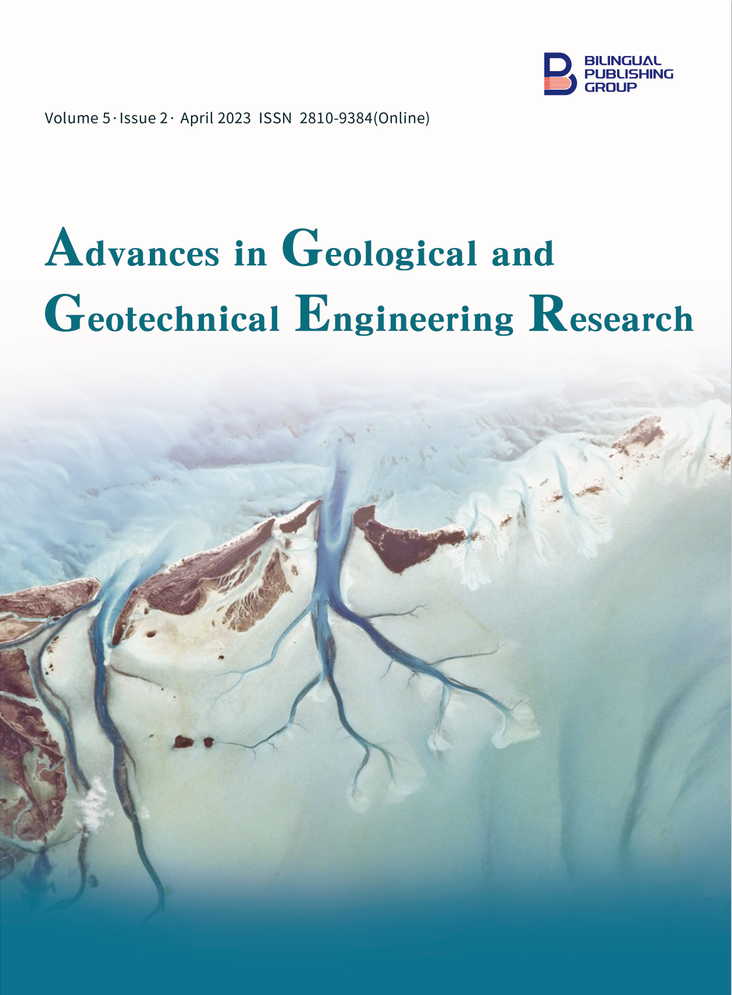-
134
-
124
-
120
-
116
-
108
Petrology and Geochemical Features of Crystalline Rocks in Ora-Ekiti, Southwestern Nigeria
DOI:
https://doi.org/10.30564/agger.v5i2.5243Abstract
This research investigates and reports on the petrology and geochemical characteristics of crystalline basement rocks in Ora-Ekiti, Southwestern Nigeria. Exhaustive geological investigation reveals migmatite, banded gneiss, granite gneiss and biotite gneiss underlie the area. In reducing order of abundance, petrographic examination reveals that migmatite contains quartz, muscovite and opaque minerals. Banded geniuses contain quartz, biotite, plagioclase, and opaque minerals. Granite geniuses contain quartz, plagioclase, biotite, microcline and opaque; while biotite geniuses contain biotite, plagioclase, opaque minerals, and quartz. Silica contents in migmatite (69.50%-72.66%; ca. 71.23%), banded gneiss (71.66%-77.1%; ca. 75.23%), biotite gneiss (72.32%-76.18%; ca. 73.83%) and granite gneiss (69.82%-73.15%; ca. 71.95%) indicate the rocks are siliceous. High alumina contents in migmatite (12.18%), banded gneiss (10.28%), biotite gneiss (11.46%) and granite gneiss (9.97%) are comparable to similar rocks in the basement complex. All the rocks show Ba, Sr and Rb enrichment. Harker diagrams of Al2O3 versus SiO2 and CaO versus SiO2 show negative trends while Na2O versus SiO2, K2O versus SiO2 and TiO2 versus SiO2 plots showed positive trends. This variation probably depicts extensive crystal fractionation in the magmatic systems that produced the rocks prior to metamorphism or partial melting of the precursor rock. SiO2 versus (Na2O + K2O) classifies the rocks as granite to granodiorite. The rocks are high K-calc-alkaline and calc-alkalic on SiO2-K2O plot. This shows the rocks are potassic meaningthat they are formed from a potassium-rich source. The plot of Al2O3/(Na2O + K2O) versus Al2O3/(CaO +Na2O + K2O) reveals the crystalline rocks are orogenic and originated from granitoid with meta luminous affinity. The rocks consist of gneisses of no economic minerals, but the petrology reveals them as common rocks typical of metamorphic terrains and geochemical features of the rocks reveal they are felsic and of granitic composition.
Keywords:
Ora-Ekiti; crystalline basement rocks; petrology; Metaluminous affinityReferences
[1] Rahaman, M.A., 1988. Recent advances in study of the basement complex of Nigeria Precambrian geology of Nigeria. Precambrian Geology of Nigeria. Geological Survey of Nigeria Publication, Kaduna. p. 11-43.
[2] Oluyide, P.O., Nwajide, C.S., Oni, A.O., 1998. The geology of the Ilorin area. Bulletin, GSN. 42, 84.
[3] Okonkwo, C.T., 1992. Structural geology of basement rocks of Jebba area, Nigeria. Journal of Mining and Geology. 35(1), 9-21.
[4] GSN, 1966. Geological Survey of Nigeria, Geological map of Akure, Sheet 61, 1:250,000.
[5] Oyinloye, A.O., Obasi, R.A., 2006. Geology, geochemistry and geotectonic setting of the Pan-African granites and charnockite around Ado-Ekiti, Southwestern Nigeria. Pakistan Journal of Science and Industrial Research. 49(5), 299-308.
[6] Obaje, N.G., 2009. Geology and mineral resources of Nigeria. Lecture notes in Earth Sciences. Springer: Berlin. pp. 72-97.
[7] Burke, K.C., Dewey, J.F., 1972. Orogeny in Africa. Africa geology. University of Ibadan Press: Ibadan. pp. 583-608.
[8] Dada, S.S., 2006. Proterozoic evolution of Nigeria. The basement complex of Nigeria and its mineral resources. Petrochemical. Services Limited Ibadan: Nigeria. pp. 29-45.
[9] Abaa, S.I., 1983. The structure and petrography of alkaline rocks of the Mada Younger Granite. Journal of African Earth Sciences. 3(1-2), 107-113.
[10] Gandu, A.H., Ojo, S.B., Ajakaiye, D.E., 1986. A gravity study of the Precambrian rocks in the Malumfashi area of Kaduna State, Nigeria. Tectonophysics. 126, 181-194.
[11] Olayinka, A.I., 1992. Geophysical siting of boreholes in crystalline basement areas of Africa. Journal of Africa Earth Science. 14, 197-207.
[12] de Swardt, A.M.J., 1953. The geology of the country around Ilesha. Bulletin of Geological Survey of Nigeria. 23, 54.
[13] Falconer, J.D., Woods, S., 1911. The geology and geography of Northern Nigeria. Macmillan and Company, limited: UK. pp.458-459.
[14] NGSA, 2006. Nigeria Geological Survey Agency Map of Ekiti State [Internet]. Available from: https://ngsa.gov.ng/
[15] Roselee, M.H., Ghani, A.A., Umor, M.R., 2016. Petrology and geochemistry of igneous rocks from southern Tioman Island, Pahang, Peninsular Malaysia. Bulletin of the Geological Society of Malaysia. 62, 79-89.
[16] Middlemost, E.A., 1994. Naming materials in the magma/igneous rock system. Earth Science Reviews. 37(3-4), 215-224.
[17] Irvine, T.N., Baragar, W.R.A., 1971. A guide to the classification of common volcanic rocks. Canadian Journal Earth Science. 8, 523-548.
[18] Peccerillo, A., Taylor, S.R., 1976. Geochemistry of Eocene calc-alkaline volcanic rocks from the Kastamona area, northern Turkey. Contribution to Mineralogy and Petrology. 58, 63-81.
[19] Shand, S.J., 1943. Eruptive rocks: Eruptive rocks, their genesis, composition, and classification, with a chapter on meteorites. Science. 99(2562), 101-102
Downloads
How to Cite
Issue
Article Type
License
Copyright © 2023 Olusola A. OlaOlorun, Akinola O.O, Oyinloye A.O.

This is an open access article under the Creative Commons Attribution-NonCommercial 4.0 International (CC BY-NC 4.0) License.




 O. A. OlaOlorun
O. A. OlaOlorun






